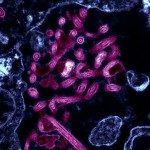Link to Pubmed [PMID] – 31773804
Link to DOI – 10.1002/uog.21936
Ultrasound Obstet Gynecol 2020 Nov; 56(5): 740-748
To describe placental findings on prenatal ultrasound and anatomopathological examination in women with Zika virus (ZIKV) infection, and to assess their association with congenital ZIKV infection and severe adverse outcome, defined as fetal loss or congenital Zika syndrome (CZS).This was a prospective study of pregnancies undergoing testing for maternal ZIKV infection at a center in French Guiana during the ZIKV epidemic. In ZIKV-positive women, congenital infection was defined as either a positive reverse transcription polymerase chain reaction result or identification of ZIKV-specific immunoglobulin-M in at least one placental, fetal or neonatal sample. Placental ZIKV-infection status was classified as non-exposed (placentae from non-infected women), exposed (placentae from ZIKV-infected women without congenital infection) or infected (placentae from ZIKV-infected women with proven congenital infection). Placentae were assessed by monthly prenatal ultrasound examinations, measuring placental thickness and umbilical artery Doppler parameters, and by anatomopathological examination after live birth or intrauterine death in women with ZIKV infection. The association of placental thickness during pregnancy and anatomopathological findings with the ZIKV status of the placenta was assessed. The association between placental findings and severe adverse outcome (CZS or fetal loss) in the infected group was also assessed.Among 291 fetuses/neonates/placentae from women with proven ZIKV infection, congenital infection was confirmed in 76 cases, of which 16 resulted in CZS and 11 resulted in fetal loss. The 215 remaining placentae from ZIKV-positive women without evidence of congenital ZIKV infection represented the exposed group. A total of 334 placentae from ZIKV-negative pregnant women represented the non-exposed control group. Placentomegaly (placental thickness > 40 mm) was observed more frequently in infected placentae (39.5%) than in exposed placentae (17.2%) or controls (7.2%), even when adjusting for gestational age at diagnosis and comorbidities (adjusted hazard ratio (aHR), 2.02 (95% CI, 1.22-3.36) and aHR, 3.23 (95% CI, 1.86-5.61), respectively), and appeared earlier in infected placentae. In the infected group, placentomegaly was observed more frequently in cases of CZS (62.5%) or fetal loss (45.5%) than in those with asymptomatic congenital infection (30.6%) (aHR, 5.43 (95% CI, 2.17-13.56) and aHR, 4.95 (95% CI, 1.65-14.83), respectively). Abnormal umbilical artery Doppler was observed more frequently in cases of congenital infection resulting in fetal loss than in those with asymptomatic congenital infection (30.0% vs 6.1%; adjusted relative risk (aRR), 4.83 (95% CI, 1.09-20.64)). Infected placentae also exhibited a higher risk for any pathological anomaly than did exposed placentae (62.8% vs 21.6%; aRR, 2.60 (95% CI, 1.40-4.83)).Early placentomegaly may represent the first sign of congenital infection in ZIKV-infected women, and should prompt enhanced follow-up of these pregnancies. Copyright © 2019 ISUOG. Published by John Wiley & Sons Ltd.


